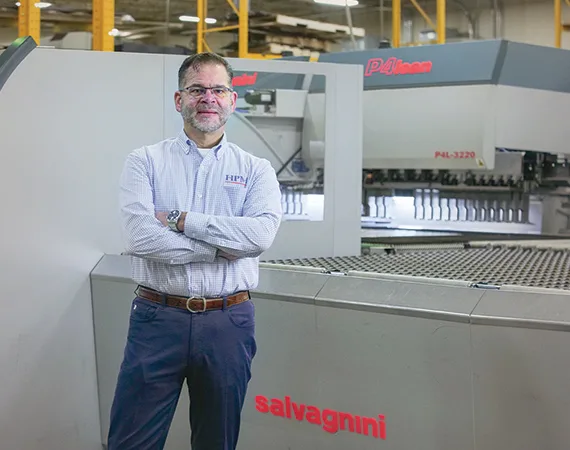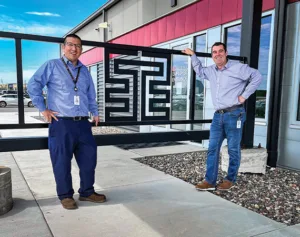Brothers Tim and Pat Herold grew up in the precision sheet metal and assembly industry, watching and then working for the company their father started. When they kicked off Herold Precision Metals in 1997, establishing a culture of respect for individuals and ensuring transparent communication were top priorities.
Like most manufacturers, White Bear Township-based HPM has endured one challenge after another over the last three years. Each time HPM cleared one hurdle, the company faced another. During those trials, HPM’s core values – strive to be better, respect, passion and integrity – guided every action.
When business slowed in the early stages of COVID-19, the company launched a plan to reduce hours but keep pay whole. “We literally laid out a plan for how long our funds would last us to be able to take care of our families,” says Tim Herold, HPM’s president and CEO. “I have always said we have two customers: those who pay the bills and those who make the parts.”
HPM went to a company-wide 32 hour, full-pay work week for its 122 employees in the early stages of the pandemic, before Congress authorized PPP payments for employers. Business picked up again after about 12 weeks, and the company resumed its normal work schedule. Since then, the only attrition the company has had is from retirements.
As the pandemic wore on, Herold knew other companies were facing troubles, so HPM sent out mass emails every couple of weeks to get updates from vendors in the company’s critical supply base. “We wanted to make sure we had a good pulse on who might be struggling and how that might ultimately affect our workload and our customer service,” Herold says. Of HPM’s vendors, 90% have been working with the company since its beginning.
HPM survived that first summer, but starting in September 2020 it faced what would quickly become a heart-stopping 200-300% increase in raw material costs. The company forwarded copies of invoices and purchase-order confirmations from its vendor network to critical customers to try to validate price increases. “Our goal was to be as transparent as possible,” Herold says. “Most customers were very understanding.”
Process improvement
In the midst of these external crises, HPM was implementing major process changes. Greg Schreier, HPM’s general manager, says the manufacturer ran on the intuition of its founders for its first 20 years.
To build on this base and formalize it, HPM contracted with a third party to implement a strategic planning process. Every action taken within the annual strategic plans reflects the company’s culture of transparent communication and emphasizes relationships.
At a series of offsite meetings each fall, the leadership team agrees on revenue and income goals, as well as projects to support these goals. “Normally everybody has eight to 10 projects they want to get done,” Schreier says. “With seven leaders that could be 70 projects. There’s no way all that’s going to get done.”
He uses the planning sessions to pare down the ideas to those that can actually be accomplished. Schreier tracks the implementation of the ideas through software and monthly follow-up meetings.
One of the strategic plan projects called for HPM to bring in Enterprise Minnesota to improve outcomes on the shop floor. An outgrowth of these sessions was to set up 4’x6’ Gemba boards in each department to keep teams on the same page with respect to key objectives. Schreier says all department leads have been trained in how to manage and communicate about the Gemba boards.
“Safety, quality, delivery, and productivity — in that order — are our goals,” Schreier says.
The process enables leads to run their departments as their own business, according to Schreier. “As part of that, every Monday morning the entire leadership team, before our staff meeting, goes around to these Gemba boards and each of the leads reviews the previous week.”
Schreier calls the results “one of the bigger cultural transformations in a workforce that I’ve been involved with. It gives everybody in the building real visibility about the performance of each department, and it also connects leadership very closely to the shop floor, which is one of our closely held cultural virtues here.”
Strategic planning has yielded other wins for the company as well. Last year, HPM added a director of IT to help the company fully utilize its enterprise management software. They hired an experienced programmer who has used that software to revamp the entire operation, from inventories to scheduling, to ensure HPS is as accurate and efficient as possible with its information. “She’s been on board now for about six months, and we’re already starting to see gains from that,” says Schreier.
HPM also continues to prioritize automation, adding tools that “help humans, not eliminate them” Herold says. HPM employees understand the need for automation to make up for a lack of personnel. They also see the value for improved quality and employee wellness.
If employees are working with big parts, near the end of a full shift when they are tired, there’s likely to be what Herold describes as a misgauge; they don’t hold the part the exact same way each time and the cut is different.
Automated systems with AI and self-correction features eliminate that possibility. At the same time, Herold says, “the new automated forming system took a ton of physical labor off the backs of our guys, and we love that.”



